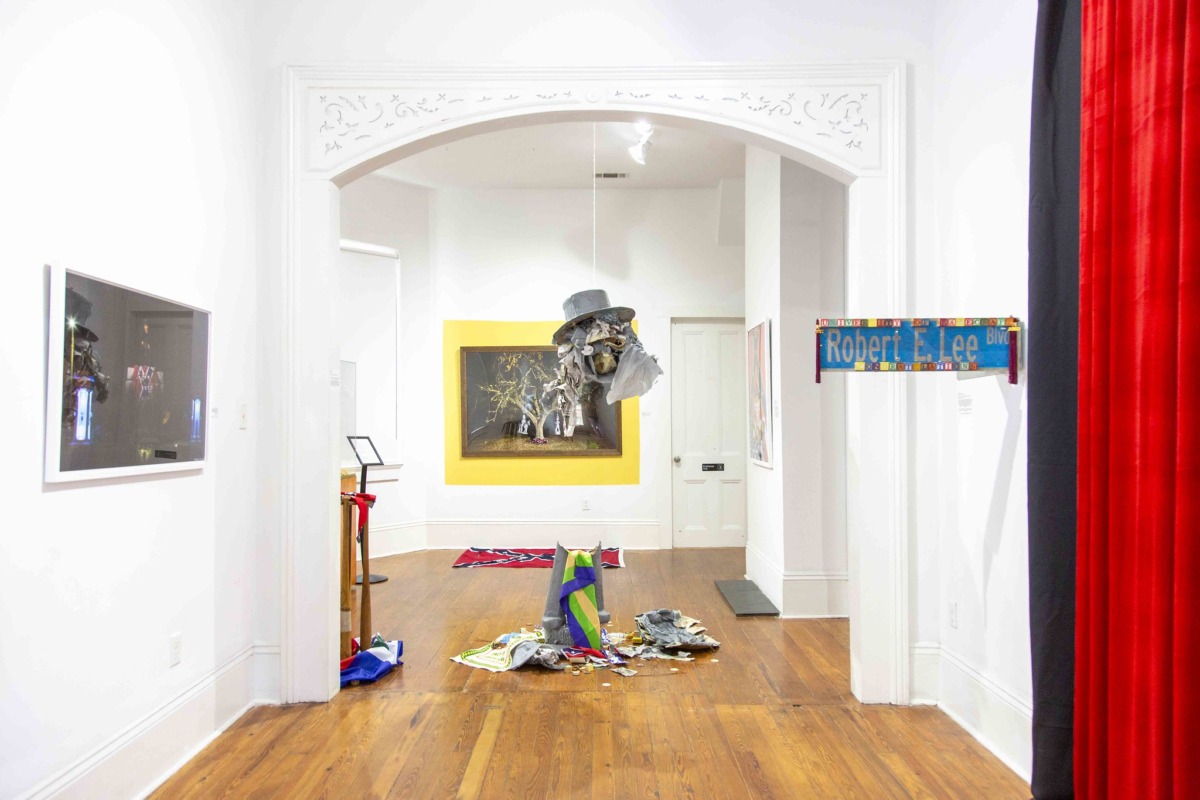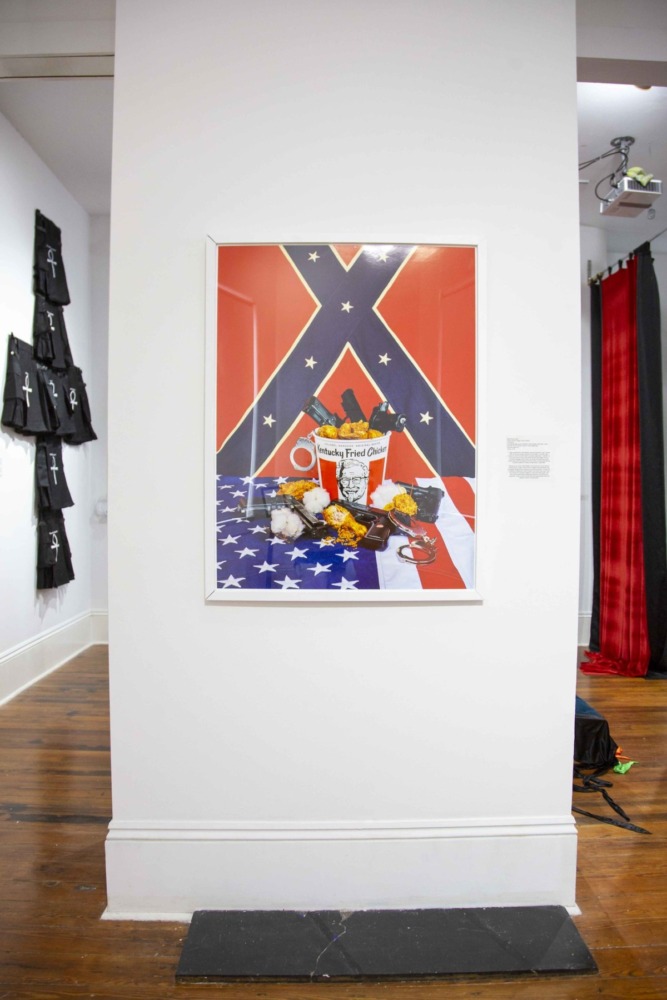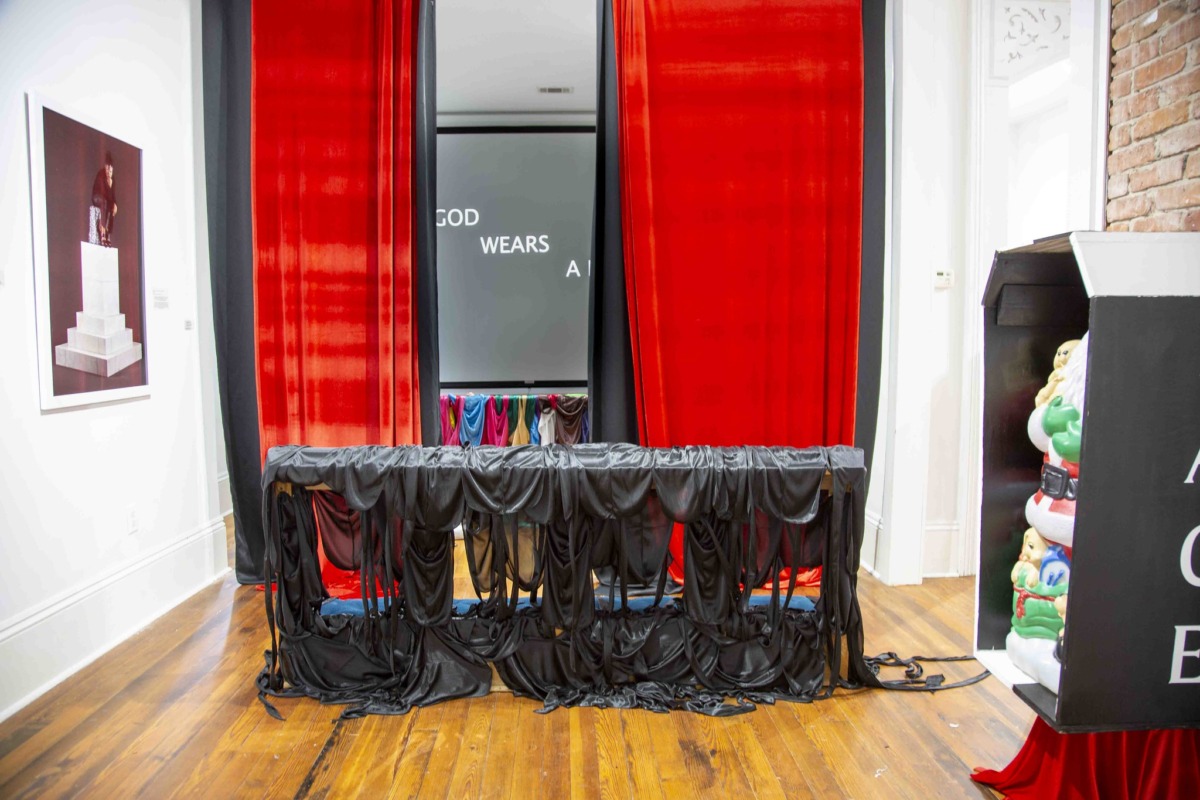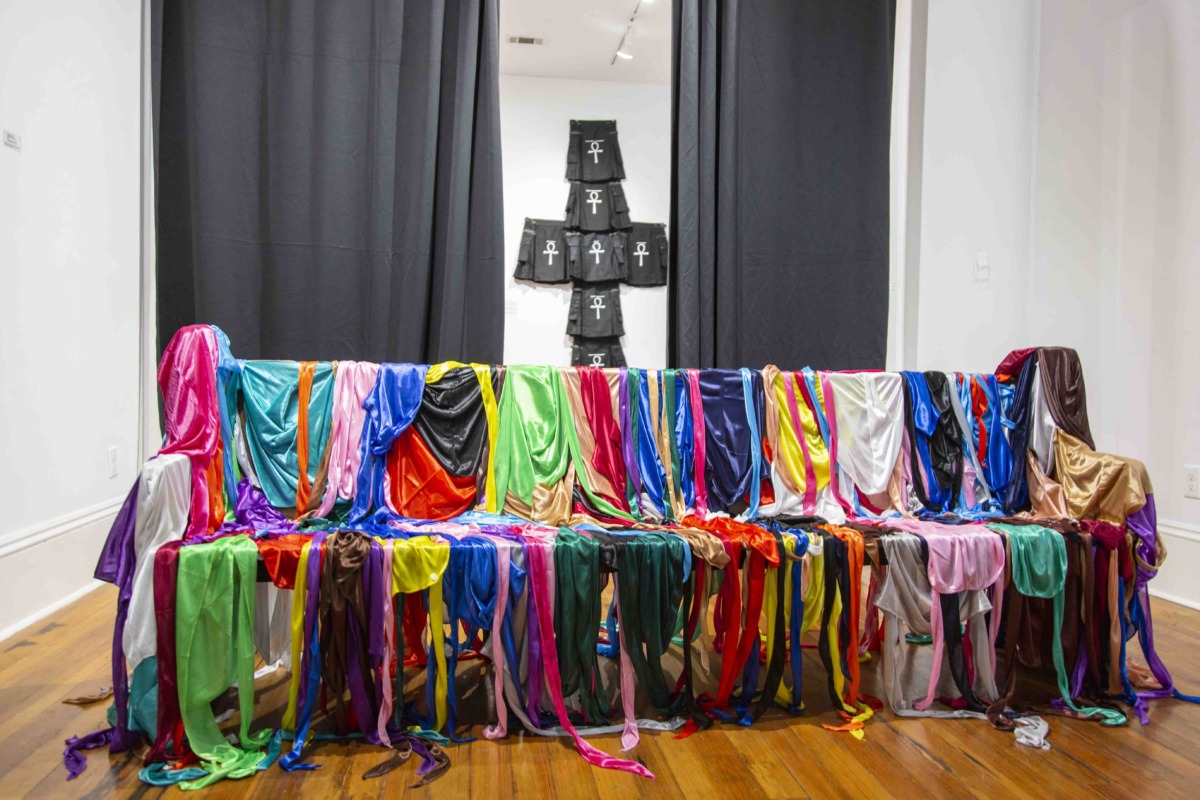
Nic[o] Brierre Aziz’s (b. 1990, New Orleans) exhibition titled “I’d rather get out of jail than get 1,000,000 dollars” at Antenna Gallery in New Orleans, offered a space in which viewers could contemplate the role of art and the artist—within immediate communities and the art world at large.
In November 2021, Aziz published an article in Hyperallergic titled “When ‘Art’ Dies, the Community Will Thrive.” It opened with the provocative statement, “Art and artists need to die.” What he meant was that the notion of art as a precious commodity and the artist as an individual genius both need to evolve. As he stated, “…the concepts and foundations of these two things as manifestations of imperial-induced greed and elitism need to die, in order to be reborn.” Fittingly, Google defines “art” as the following:
The expression or application of human creative skill and imagination, typically in a visual form such as painting or sculpture, producing works to be appreciated primarily for their beauty or emotional power.
A great deal of emphasis here is placed on ability, creativity, and allure. Aziz discusses how Indigenous languages from Africa and the Americas lack this written definition for “art.” In the opening text for the exhibition’s catalog, he notes:
“Art in communities such as Ife (an ancient Yoruba city in southwest Nigeria) was simply a translation of a feeling or experience into a physical object to be shared with others—sometimes having a royal or spiritual significance.”
Made as offerings for communities to challenge power structures, the work featured in Aziz’s first solo exhibition reimagines “art” as rooted in the communal and informed by Indigenous perspectives.

How does Aziz’s exhibited artwork function within Black communities under attack? For Aziz, it seems as though art can function as a tool for exposing and challenging oppressive systems, like the weapon featured in Strange Brute (Hanging from the Poplar Trees) II (2022). Brandishing a baseball bat with the Haitian flag wrapped around one end, the artist/activist locks his gaze and aim on a grey piñata in the form of a monument to Confederate General P. G. T. Beauregard, symbolically hung from a live oak. At the base of the oak’s trunk lies the remnants of a burned Confederate flag—the charged emblem whose creation Beauregard insisted upon after much confusion at the First Battle of Bull Run. On the other end of the tree hangs a second piñata, an equestrian statue of General Robert E. Lee. With his weapon wrapped in a revolutionary flag, Aziz makes clear his intent and purpose, while also employing a sense of play and humor that disarms as well as demolishes these previously public symbols of white supremacy.
Part of a series titled Juguete—Spanish for “plaything”—Strange Brutes documents the artist’s engagement with these ephemeral vessels—pointing to the fragility of the structures they once reinforced. At the opening of his exhibition, Aziz invited visitors to bash a similar looking piñata. Visitors so thoroughly destroyed the little plaything, that by the time I saw the exhibition in late February, I couldn’t tell you which white supremacist it once represented.
The racialized terror that these works reference, as well as the retributive violence the performance allowed for, calls to mind a line from a letter that Haitian General Toussaint Louverture wrote to Jean-Jacques Dessalines. In the letter, Louverture orders Dessalines to “burn and annihilate everything in order that those who have come to reduce us to slavery may have before their eyes the image of the hell which they deserve.” Much like these revolutionary leaders, comprehension and confrontation represent essential threads in the Haitian New Orleanian artist’s practice, not simply for promoting a political message but also in understanding his personal story.

In many works, such as in the video portion of My God Wears a Durag (2022)—which features endearing clips of Aziz as a child posing for the camera in a Santa hat and dancing in the kitchen with his dad—the artist visually inserts himself. Aziz offers himself up as “art”—as “a physical object to be shared with others.” The catalog featured a sweet picture of the artist as a toddler sleeping in his father’s arms while seated in front of a large historical painting by his uncle, Haitian artist Ulrick Jean-Pierre. The image offers glimpses into an intimate and vulnerable realm of the artist that reminds us to treat artists and the objects they create with care. Quotes found throughout the gallery and published essays by family members in the accompanying catalog further demonstrated that a star is not born but created in community.
Accordingly, Aziz exams the Black artist’s relationship to the art market. His on-going White Barbies series—including video works Tha Block is Hot (2020) and Pimpin’ Ain’t Easy (2020)—invites one to consider colonial histories and connections to the trade of Black art and Black people. White Barbies is derived from a phrase shared with Aziz in 2017 by local legend “Mama Jennifer” of the Community Book Center in New Orleans. Mama Jennifer had relayed how insufficient the term “white supremacy” felt when what has been enacted against Black people could be more accurately termed: “white barbarism.” Revealing the barbaric nature of actions informed by white supremacist ideology from slavery to the present, Tha Block is Hot ties the sale of Black and Africa art during the twentieth century and in the contemporary moment to the history of slave auctions.
The video opens with a clip from James Baldwin’s 1963 speech, “The Artist’s Struggle for Integrity,” in which the writer ponders aloud on the role of an artist in a broken society. As Baldwin’s speech ends, the tempo adjusts and Ye’s (formerly Kanye West) “Blood on the Leaves”—a song sampling Nina Simone’s rendering of “Strange Fruit,” the powerful anti-lynching ballad first popularized by Billie Holiday—begins to play.
Quotes found throughout the gallery and published essays by family members in the accompanying catalog further demonstrated that a star is not born but created in community.
The screen goes black for a moment, and then we hear the screams of Eliza being ripped from her children in the 2013 film Twelve Years a Slave, adapted from Solomon Northup’s memoire from 1853. Images of art auctions at Sotheby’s and Christie’s move quickly and in contrast against film scenes, newspaper ads, and historic prints featuring antebellum slave sales. An anonymous British man declares, “I think the one thing I like about auctions is that they are so democratic.” His voice narrates film scenes of shackled Black men, women, and children being physically inspected by slaveholders, leaving viewers with no question as to who has historically been permitted access to “democracy.” Tha Block Is Hot draws a clear line between the valuation and hyper-consumption of Black people and Black art, a theme throughout the series.

Played to the soundtrack of Biggie’s “Gimme the Loot,” Pimpin’ Ain’t Easy features news reports and archival images documenting the colonial plundering of African art and resources and calls for repatriation. The video closes with an interview with famed Haitian, Puerto Rican American artist Jean-Michel Basquiat comes on-screen. Basquiat explains, “I like to remain a little reclusive and not… be out there…just to be brought up and be brought down, you know, like they do to most of them.” His words reveal an important factor of the artist’s volatile relationship to the art world, and society writ large, that led him to write a specific phrase repeatedly in his journal over the years: “I’d rather get out of jail than get 1,000,000 dollars.” Borrowed as the titular sentence of Aziz’s exhibition, this contentious relationship would contribute to Basquiat’s poor mental health and premature death at twenty-seven.
Created over the past five contentious years, the pieces that comprised Aziz’s exhibition challenged the definition of “art” in utilizing performance, photography, installation, and film to allow visitors to sit with and challenge anti-Blackness in our world. When Aziz said, “Art and artists need to die,” what he really means is: white barbarism must die.





